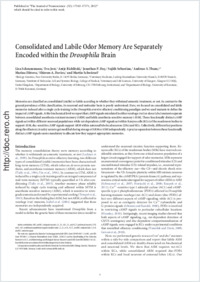Consolidated and labile odor memory are separately encoded within the Drosophila brain
- Scheunemann, Lisa Biology-Genetics, Free University Berlin, Germany
- Jost, Eva Veterinary Medicine, Ludwig-Maximilians University Munich, Germany
- Richlitzki, Antje Biology-Genetics, Free University Berlin, Germany
- Day, Jonathan P. Institute of Molecular, Cell and Systems Biology, University of Glasgow, United Kingdom
- Sebastian, Sujith Institute of Molecular, Cell and Systems Biology, University of Glasgow, United Kingdom
- Thum, Andreas S. Department of Biology, University of Fribourg, Switzerland - Department of Biology, University of Konstanz, Germany
- Efetova, Marina Biology-Genetics, Free University Berlin, Germany
- Davies, Shireen-A. Institute of Molecular, Cell and Systems Biology, University of Glasgow, United Kingdom
- Schwärzel, Martin Biology-Genetics, Free University Berlin, Germany
-
2012
Published in:
- The Journal of Neuroscience. - 2012, no. 32, p. 17163-17171
English
Memories are classified as consolidated (stable) or labile according to whether they withstand amnestic treatment, or not. In contrast to the general prevalence of this classification, its neuronal and molecular basis is poorly understood. Here, we focused on consolidated and labile memories induced after a single cycle training in the Drosophila aversive olfactory conditioning paradigm and we used mutants to define the impact of cAMP signals. At the biochemical level we report that cAMP signals misrelated in either rutabaga (rut) or dunce (dnc) mutants separate between consolidated anesthesia-resistant memory (ARM) and labile anesthesia-sensitive memory (ASM). Those functionally distinct cAMP signals act within different neuronal populations: while rut-dependent cAMP signals act within Kenyon cells (KCs) of the mushroom bodies to support ASM, dnc-sensitive cAMP signals support ARM within antennal lobe local neurons (LNs) and KCs. Collectively, different key positions along the olfactory circuitry seem to get modified during storage of ARM or ASM independently. A precise separation between those functionally distinct cAMP signals seems mandatory to allocate how they support appropriate memories.
- Faculty
- Faculté des sciences et de médecine
- Department
- Département de Biologie
- Language
-
- English
- Classification
- Biological sciences
- License
-
License undefined
- Identifiers
-
- RERO DOC 30942
- DOI 10.1523/JNEUROSCI.3286-12.2012
- Persistent URL
- https://folia.unifr.ch/unifr/documents/302599
Statistics
Document views: 117
File downloads:
- pdf: 155
